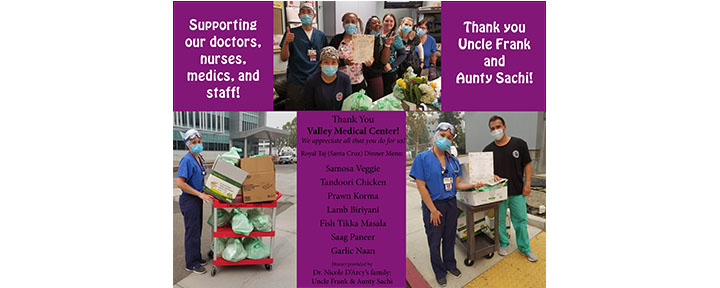
First it was PPE. Then it was toilet paper. Now it’s paper towels? I get there being a run on PPE – after all, it is the personal protective equipment that medical and front-line responders need to stay safe while doing their jobs. I never understood why toilet paper became scarce, and now paper towels?
I have a solution: DON’T USE PAPER TOWELS AT ALL!
Paper towels are the most wasteful product invented by companies like Proctor and Gamble. Before their relatively recent invention, we used cloth towels. They’re much more absorbent and stronger than any paper towel – even the “Quicker Picker Upper.” They can be washed and dried with your towels, and then reused hundreds of times. See my blog about Cloth vs Paper Towels: No Contest!
I even carry a cloth towel in my purse and in my car so I have one everywhere I go. If public restrooms don’t have an air dryer, I just pull out my cloth towel and wipe my hands. After touching the faucet (ooh, cooties!), I safely dry my hands.
Check out my YouTube video on simple ways to reduce paper waste. So if people start hoarding paper towels, just cut up old cloth towels and you’ll be all set for 10 years!

First it was PPE. Then it was toilet paper. Now it’s paper towels? I get there being a run on PPE – after all, it is the personal protective equipment that medical and front-line responders need to stay safe while doing their jobs. I never understood why toilet paper became scarce, and now paper towels?
I have a solution: DON’T USE PAPER TOWELS AT ALL!
Paper towels are the most wasteful product invented by companies like Proctor and Gamble. Before their relatively recent invention, we used cloth towels. They’re much more absorbent and stronger than any paper towel – even the “Quicker Picker Upper.” They can be washed and dried with your towels, and then reused hundreds of times. See my blog about Cloth vs Paper Towels: No Contest!
I even carry a cloth towel in my purse and in my car so I have one everywhere I go. If public restrooms don’t have an air dryer, I just pull out my cloth towel and wipe my hands. After touching the faucet (ooh, cooties!), I safely dry my hands.
Check out my YouTube video on simple ways to reduce paper waste. So if people start hoarding paper towels, just cut up old cloth towels and you’ll be all set for 10 years!

If you’re interested in transferring from a California community college to a UC campus, this is the time to set up your Transfer Admission Guarantee (TAG). Six UC campuses offer a TAG to college students who meet specific requirements.
One of the benefits of having a TAG is that you will receive early review of your academic records, early admission notification and specific guidance about major preparation and general education coursework.
TAG applications are due Sept. 30, but you can only apply for a TAG at one campus. To keep your options open, apply to other UC campuses during the regular application cycle (Nov. 1-30).
Here’s how it works:
1. Use the UC Transfer Admission Planner to complete the TAG application, and review it with your community college counselor and/or UC campus TAG adviser. You’ll need to submit it Sept. 1–30.
2. You’ll find out if your TAG is approved in November. If it is, fulfill all remaining coursework and GPA requirements in your TAG agreement.
3. You still need to fill out the application for admission to UC and submit it Nov. 1–30.
Transfer Admission Guarantee (TAG)
Six UC campuses offer an admission guarantee for junior transfer applicants. These campuses include UC Davis, UC Irvine, UC Merced, UC Riverside, UC Santa Barbara and UC Santa Cruz.
By participating in the program, students can ensure their admission to a specific UC campus and major. Over 80% of students admitted through the TAG program choose to enroll in a UC campus. TAG students come to UC prepared, with 61% graduating in two years. UC’s TAG Matrix provides information about the GPA, major preparation, and other criteria required by each campus.
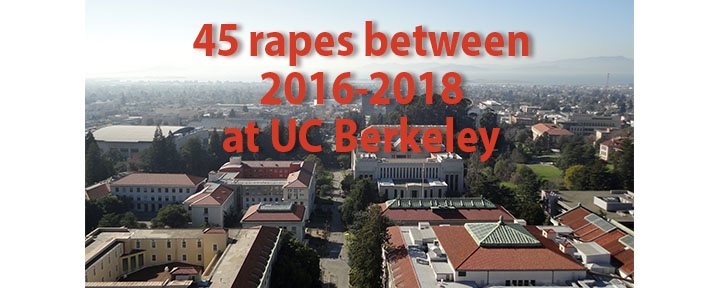
Colleges are supposed to report all campus crimes so parents and students can understand the safety of the campuses they consider when applying to colleges. But UC Berkeley improperly reported over 1000 crimes that involved weapons, drugs and liquor, and sexual offenses, which just landed them a $2.35 million fine.
In the 2019 “Annual Security and Fire Safety Report, UC Berkeley disclosed that there were 19 rapes on campus and another 26 rapes off campus between 2016-2018. There were also 53 incidents of aggravated assault.
Concerned about the colleges your child is applying to this year? Thanks to the Clery Act, colleges and universities are required to disclose all crimes from drinking violations to sexual assault every year. Ask the admissions office for a copy of their crimes report. The more parents request these reports, the sooner colleges will crack down on crimes against students on their campuses.

The California State University (CSU) system has announced that their all of their campuses will continue to have remote learning for spring semester 2021. I’m glad to hear that they have made this decision and have communicated their plans with their students, faculty, and staff so everyone can make plans accordingly. It’s the respectful and responsible thing to do. I wish all campuses would do the same. The sooner we stop the spread of the coronavirus, the sooner we can get back to school and work! It’s really that simple.
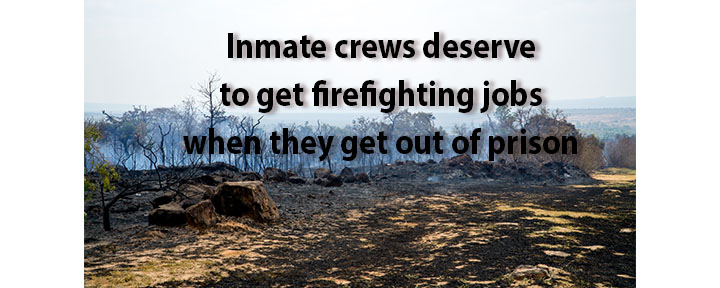
One of my students is exploring ways to stop wildfires from destroying millions of acres of forests in California. He was evacuated from his home and felt helpless because he couldn’t do anything to defend his neighborhood from the oncoming lightning-strike fires. He says that we need to recruit volunteers to create fire breaks in distant areas to stop future wildfires.
Then we learned that the fire department recruits and trains inmates to do the clearing, limbing, and other crucial preventative work both before the fire season and during actual mitigation of wildfires. That seems like a great way to utilize inmates by giving them valuable skills and using their manpower to do the heavy lifting that official firefighters often don’t have enough staff to do. To become part of an inmate crew, they must have non-violent behavior and conformance to rules while they are in prison and their original crimes must not include sex offenses, arson, or history of escape. These inmates earn around $2.50 an hour while they worked on inmate crews. It seems like a win-win situation for everyone.
One would think that after an inmate (who was trained to do firefighter tasks) does his time in prison, he would be able to apply for a job as a firefighter when he is released. That would make sense and it would be the best form of rehabilitation. But inmates can’t become firefighters after they’ve done their time because they don’t qualify to get their Emergency Medical Technician certificate – a requirement to become a California firefighter. Bureaucracy!
Governor Newsom has until Sept 30th to sign AB2147 that will expunge criminal records from formerly incarcerated people who have been trained at state fire camps while they were in prison. I hope he signs this so we can increase the quantity of firefighters here in California and to give these people a second chance at life.
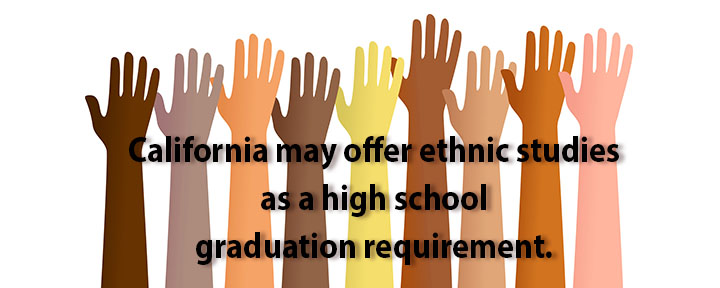
California high school students may be required to take a one-semester ethnic studies course as part of their high school graduation requirements. This comes on the heels of the Black Lives Matter upheaval that has caused our nation to rethink systemic racism. By offering a class that explores the cultural and historical history of African Americans, Latinos, Native Americans, and Asian Americans/Pacific Islanders, all students will learn about the people who make up the America population and not just the Eurocentric history that is laid out in their history books.
I remember wondering why the internment of the 120,000 Japanese Americans (US citizens!) during WWII was never mentioned in my US History class. Or why textbooks described how the Atlantic Slave Trade brought millions of “workers” from Africa, and didn’t address the inhumanity of enslaving Africans and selling them like livestock when they arrived between 1500-1800.
Critics of the high school curriculum say that the course leaves out Armenians and Muslims. I’m sure other groups will come forward with other complaints of omissions but this is a good step in the right direction. Maybe this course could include “Lies my Teacher Told Me; Everything Your American History Textbook got Wrong” by James Loewen. Let’s include ethnic studies in all US high school curriculum – I believe it will help us appreciate our differences. Another avenue to consider is interracial marriages – that forces the conversation and creates a “melting pot” of beautiful children.
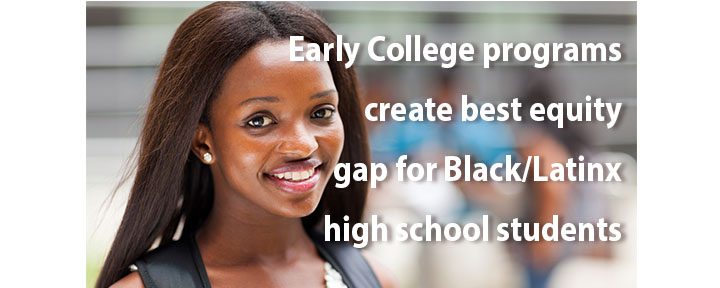
The “Early College” programs offered in public high schools offer the best solutions to equity gap problems. These programs allow high school students to take career-oriented college classes at a local community college for free and to earn college credit while they are still in high school. The best part: over 75% of these students enroll in college and complete the FAFSA (financial aid app) upon high school graduation.
In states like Massachusetts, the majority of the students who enrolled in the Early College program were Black, Latinx or from other underrepresented ethnic groups. By giving these and all students the opportunity to take a few college classes while in high school, they’re getting a taste for college and getting credits for free. Ambitious students can take several college classes, which can save them thousands of dollars.
These Early College programs are also pandemic proof. High school students can take online community college classes that satisfy high school graduation requirements and start chipping away at college graduation requirements.
It’s a win-win!
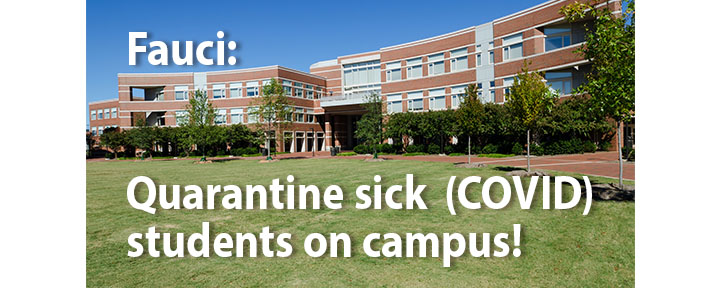
When college kids get COVID-19 and they’re hundreds or thousands of miles from home, they’re going to want to be with their families. Being sick and homesick at the same time is just awful. They’ll want Mom’s chicken soup and other comfort foods that only a mother can give.
But Dr. Fauci says that colleges should NOT send students sick with COVID-19 back home. Instead colleges are now required to take care of the sick students by quarantining them and giving them medical attention. And they should! Imagine what would happen if thousands of students with COVID-19 travelled across city, state, or even continental lines? The college students alone could create the 2nd wave.
Many of the colleges that opened up their campuses to students this fall made these decisions based on the financial health of the institution. Some colleges share the responsibility of managing dorms and food services with third parties or partners. With pressure from business partners to fill the dorms, many colleges invited students back for classes this fall. Losing room and board from students while paying for high costs of dorm remodels to protect students when they return to campus could be a financial nightmare.
There are still so many unknowns about the spread, treatment, and prevention. Until we fully understand the wrath and potential of this virus, I wish everyone would stay home. The more cases that pop and surge on college campuses, surrounding neighborhoods, and back in students’ home towns, the longer it will take to contain this pandemic.

I wish the experts didn’t warn us that the coronavirus only affects old and sick people because young and healthy people still believe that they’re somehow immune. Over the past 2 weeks, college campuses are facing high infection rates among the 18-22 year old students who just arrived on campus. But the most alarming news is that a third of the college athletes (Big Ten Conference) who tested positive for COVID-19 have potentially dangerous inflammation of their heart muscle.
MRI scans showed that these athletes have myocarditis, an inflammation that can be deadly if not treated. 30-35 percent of these athletes have inflamed hearts. Some football teams have pushed back and postponed the season, while others are forging forward with modified seasons.
Why is this not headline news? These athletic institutions are BIG MONEY MAKERS and nearly a third of them wouldn’t report the number of student athletes who tested positive for COVID-19. Many also wouldn’t divulge their coronavirus protocols for athletes. Student athletes shouldn’t be required to put themselves in vulnerable positions by playing sports amid a pandemic. This is just wrong on so many levels.

